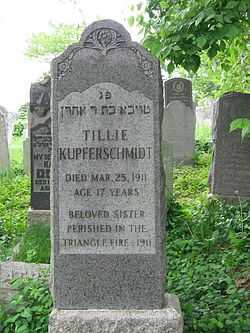Hebrew Free Burial Association
The Hebrew Free Burial Association (HFBA) was established in 1888 as a free burial society serving the residents of Manhattan's Lower East Side and was incorporated as a non-profit organization in 1889. As the need grew in adjacent Jewish communities, HFBA also grew to serve the broader metropolitan area of New York City. HFBA is currently the largest free burial society outside of Israel.[1]
The primary function of HFBA is to provide free burials to all indigent Jews in New York City, regardless of denominational affiliation. Burials are conducted in accordance with Jewish law. If not for HFBA, an indigent person in New York City could be buried in a mass grave in Potter's Field after lying in a morgue for up to a month, or may be transferred to medical, dental, chiropracter, occupational therapy or physical therapy schools for dissection education and/or research. HFBA, through its many contacts with City and social service agencies, is notified about Jewish decedents and makes arrangements so that every Jew receives a funeral and burial that is prompt, dignified and in keeping with Jewish traditions.
People buried

HFBA's clients have primarily come from among the impoverished, from the margins of society or from immigrant communities. Early in its history, they were victims of disease epidemics, occupationally hazardous conditions, poor medical care, lack of proper sanitary conditions and high infant and mother mortality rates. In its annual report from 1900, HFBA's directors wrote, "What little they may have had quickly vanished for doctor's services and medicines, and even their belongings were pawned by them to obtain the wherewithal to save their loved one from the grim monster-death."[2]
In the early years of the organization's existence, the majority of burials were of small children. In 1911, HFBA provided burials for 22 young victims of the Triangle Shirtwaist Factory fire.[3] Bodies were shipped from Manila during the Spanish–American War and at least one soldier's body arrived from New Guinea in the South Pacific during World War II. Large immigrant groups, such as Holocaust survivors and refugees from the former Soviet Union have also been prominently represented in HFBA's cemeteries, including Victor Ourin and Aaron Kuperstock, well-known Russian poets. Those who have needed HFBA's help over time have ranged from the parents of Eddie Cantor and Clara Bow, celebrities in their times, Mel Brooks' grandparents,[4] and inmates from Rikers Island and Sing Sing prisons.
Russian community
Over the last decade, many of HFBA's clients have been from the Russian Jewish community and were elderly or ill when they arrived in the United States. Experience has shown that although their Jewish identity may have been hidden or denied in the former Soviet Union, they, or their families, expressed the desire for a proper Jewish burial. HFBA's newsletter, Chesed, has an entire section written in Russian to make sure that this community feels embraced in life as well as in death.
On December 4, 2006, HFBA launched a Russian edition of their website, to further reach out to members of that community.
HFBA now employs a Russian Outreach Coordinator to improve its relationships with the Russian-Jewish Community. In an effort to improve such relationships, HFBA hosted a Russian-Jewish Community Event on February 22, 2009 featuring poetry readings and a silent art auction.
Cemeteries
HFBA owns and operates two historic cemeteries on Staten Island, New York: Silver Lake Cemetery and Mount Richmond Cemetery.
Established in 1892, Silver Lake Cemetery was the first cemetery used by the HFBA to bury New York’s indigent Jews. For the next seventeen years, close to 15,000 Jews from New York’s Lower East Side were buried on this gently inclined hillside. Some days saw the interment of over a dozen individuals, mostly children.
Mount Richmond Cemetery was established in 1909, in response to the need for more graves for New York’s indigent Jewish community. Currently, the Hebrew Free Burial Association buries approximately 300 Jews a year, and nearly 60,000 Jews have been buried since Mt. Richmond’s inception.
Volunteer program
HFBA manages a Cemetery Clean-Up Project, where groups come to Silver Lake Cemetery, and participate in its upkeep. The volunteers rake leaves and clear debris, demonstrating that the cemetery has not been forgotten, and that the Jewish Community realizes its obligation to its earlier generations.
Among the groups that have participated in the Cemetery Clean-Up Project are:[5]
- Brooklyn College Hillel
- Brooklyn Heights Group of Synagogue Youth (BHGSY)
- DRS High School
- HAFTR (Hebrew Academy of the Five Towns and Rockaways)
- Hebrew Academy of Nassau County
- Marsha Stern Talmudical Academy (Yeshiva University High School for Boys)
- Ma'ayanot Yeshiva High School
- North Shore Hebrew Academy High School
- North Shore Hebrew Academy Middle School
- Samuel H. Wang Yeshiva University High School for Girls
- SAR Academy
- Solomon Schechter School of Queens
- Solomon Schechter School of Westchester High School
- Stella K. Abraham High School for Girls
- Yavneh Academy
- Yeshiva of North Jersey
- Yeshivat Har-Torah
References
- ↑ "Hebrew Free Burial Timeline". Hebrewfreeburial.org. Retrieved 2013-07-25.
- ↑ HFBA 1900 Annual Report
- ↑ "HFBA Timeline". Retrieved March 26, 2009.
- ↑ http://www.nytimes.com/2009/04/01/nyregion/01about.html?_r=1&ref=nyregion
- ↑ "HFBA Cemetery Clean-Up Project". Hebrewfreeburial.org. 2006-05-16. Retrieved 2013-07-25.